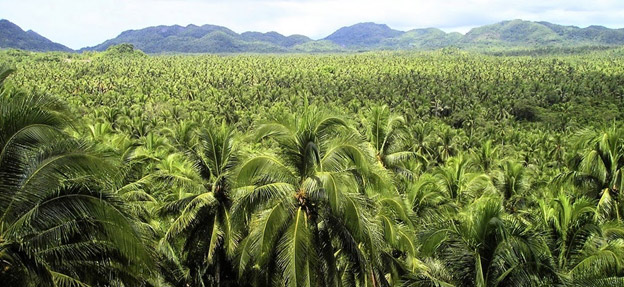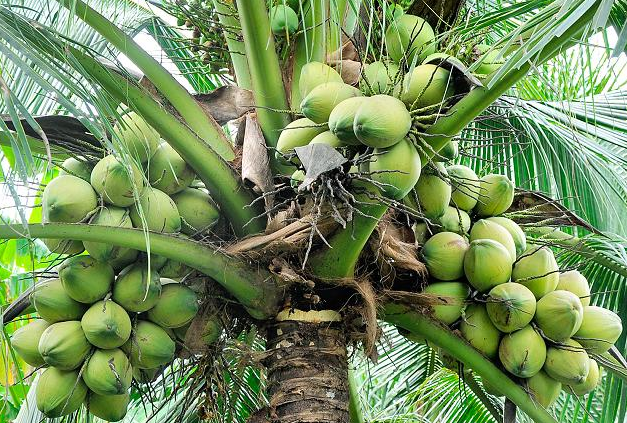Coconuts
The coconut palm is the most useful palm in the world. Every part of the tree is useful to human life for some purpose or the other. Hence, the coconut palm is endearingly called ‘kalpavriksha’ meaning the tree of heaven. The copra obtained by drying the kernel of coconut is the richest source of vegetable oil containing 65 to 70 per cent oil.
Coconut Facts
- The coconut comes from the coconut palm tree which grows throughout the tropics and subtropics.
- The name coconut is derived from 16th century Portuguese sailors who thought the 3 small holes on the coconut shell resembled the human face so dubbed the fruit “coco” meaning “grinning face, grin, or grimace” The word nut was added in English later on.
- The coconut palm (Cocos nucifera) can grow up to 30 m (98 ft) tall and the leave fronds 4–6 m (13.1–19.7 ft) long.
- Technically the coconut fruit is a drupe not a nut. Typical drupes include peaches, plums, and cherries.
- In the early stages of a coconuts growth it contains high levels of water which can be consumed directly as a refreshing drink. The water is also gaining popularity as a sports drink as it contains good levels of sugars, dietary fiber, proteins, antioxidants, vitamins, and minerals.
- Coconut water can be a substitute for blood plasma. The high level of sugar and other salts make it possible to add the water to the bloodstream, similar to how an IV solution works in modern medicine. Coconut water was known to be used during World War II in tropical areas for emergency transfusions.
- Coconut milk is not the same as coconut water. Coconut milk has a high fat content of around 17%, but is low in sugars. It is frequently added to curries and other savory dishes. Coconut cream can also be created from the milk.
Coir (the fiber of the husk) can be used for making ropes, mats, brushes, sacks, caulking for boats, and as stuffing for mattresses.
- Coconut leaves have many uses such as for making brooms, woven to make baskets or mats, or dried and used as thatch for roofing.
- The white, fleshy part of the coconut seed is called coconut meat. It has high amounts of Manganese, Potassium, and Copper. The meat is used fresh or dried in cooking, especially in confections and desserts such as macaroons.
- Copra is the term used for the dried meat. This can be processed to produce coconut oil used in cooking, in soaps, cosmetics, hair-oil, and massage oil.
- Wood from the trunk of the coconut palm was traditionally used to build bridges, houses, huts and boats in the tropics. The woods straightness, strength, and salt resistance made it a reliable building material.
- The coconut palm is grown in over 80 countries. The top 3 coconut producing countries in 2010 were the Philippines, Indonesia and India.
- In Thailand and Malaysia, trained pig-tailed macaques are used to harvest coconuts. In fact, there are still training schools for these monkeys in parts of the countries and each year competitions are held to find the fastest harvester.
- The coconut does not get dispersed like other drupe fruits (through consumption by wildlife). Instead the coconut palm disperses its seed using the ocean. A coconut is very buoyant and highly water resistant and can travel very long distances across the ocean.
- The Maldives have a coconut palm on the country’s national coat of arms. It is the national tree and considered the most important plant on their islands.
Sales of Coconut Products go Through the Roof
THE coconut craze has reached new heights, with health food retailers struggling to meet demands for the superfood trend, as consumers spend up big for coconut-derived waters, flours and dairy replacement products, despite the high saturated fat content.
Organic food retailer Deborah Wray reports that coconut water sales have tripled in the past six months, and her eight Wray Organic stores are unable to import enough coconut flour to keep up with customer demand.
There’s also strong demand for drinking coconuts and coconut milk-based beverages, yoghurts and ice cream. Coconut oil – used for nutritional and beauty reasons – sells for up to $32.95 per liter online, while coconut flour costs $15-20 per kg. Plantations International is in the right countries at the right time to profit from this surge in demand.
Coconut Producing Countries
Harvesting Coconuts and Yields

An average well maintained plantation can get 100-400 coconuts per year, but for this example we at Plantations International will use 120 nuts per year X 1,000 trees =120,000 nuts per year.
Coconut Plantation Soil Requirements
The coconut can be grown on wide variety of soils. However, red sandy loam, alluvial, laterite and coastal sandy well-drained soils rich in organic matter and with a pH ranging from 5.0 to 8.0 are best for its growth and higher yield.
Coconut Plantation Site Selection
Site selection plays a major role in producing coconuts. Soil with a minimum depth of 1.2 to 1.5 meter and good water holding capacity should be selected for coconut cultivation. Soils with underlying hard rock or soils with water logging and poor drainage should be avoided. Clayey soils are not suitable for coconut production.
Coconut Plantation Land Preparation and Spacing
First and foremost, in any farming, size of the pit depends on the soil type and water table of the soil. In loamy soils, pits with size of 1 x 1 x 1 meter should be dug and filled with top soil to the height of 40 to 50 cm. In laterite soils, large pits are recommended and pits size of 1.2 x 1.2 x 1.2 meter should be dug and filled with loose soil, well rotten farm yard manure like cow dung and ash up to a depth of 55 to 60 cm before planting. For moisture conservation, 2 layers of coconut husk should be placed at the bottom of the pit with concave surface facing upwards while filling the pits. For prevention of termite attack, BHC 10 % DP should be sprinkled on the coconut husk. In-order to soften the hard pan of the soil, common salt of 2 kg per pit should be applied at least 6 months before the plantation.
Generally, a square system of planting is preferred with a spacing of 7.5 x 7.5 meter which will accommodate 178 coconut-palms per 1 hectare. However, a spacing of 7.0 to 10 meter is practiced in many coconut growing regions of the country.
Selection of quality seedlings is very important for better yield. Farmers should select vigorous coconut seedlings of 1 year old and having minimum of 10 cm at the collar level to plant in the farm land. Early splitting of leaves in the seedlings could be a factor of selecting good seedlings. In case of water logged areas, 18 months to 24 months old seedlings are preferred. The best planting season in coconut farming is May to June which is pre-monsoon time frame.
Coconut Propagation
Propagation is done through seeds. Seedlings can be raised on nursery beds and transplanted in the main field.
Coconut Plantation Manures and Fertilizers
The regular manuring and chemical fertilizers should be carried from the first year of plantation for proper vegetative growth, early flowering and fruit bearing. The first application of in-organic fertilizers should be carried after 3 months of coconut plantation. In case of lateritic and acidic soils, Rock phosphate is recommended as source of phosphorus. Usually fertilizers should be applied in 2 split doses during May to June and Sep to Oct months for rainfed trees. In case of irrigated palms, 4 or more equal split doses should be carried to avoid heavy rainfall period. In case of sandy soil with acidic nature, 1 kg of dolomite should be supplemented during April to May in the plant basins and should be forced into the soil. This application is in addition to regular fertilizers.
Coconut Plantation Irrigation
Coconut palms require 200 to 250 liters of water once in 4 days under basin irrigation conditions where as in summer, 40 to 45 liters of water/palm/week will increase the yield. In case of water problem, one should go for drip irrigation. The quantity of water recommended for drip irrigation is 66 % of the open pan evaporation. However, irrigating the palms depends on the soil type and climatic conditions.
Intercultural Operations in Coconut Plantations
As part of inter-cultural operations, ploughing, digging and forming small mounds during the months of Aug-Sept and spreading them in the months of Dec to Jan should be carried out. Other beneficial operations are, making shallow basins with a radius of 2 meter before the onset of monsoon and filling them at the close of monsoon. In order to control the weeds, regular inter-cultural operations are advised. Mulching can be done at tree basins with dry hay to retain the moisture, control the weed growth and protect the soil from erosion.
Inter-cropping Coconut Plantations
Farmers can utilize the inter-space in the coconut palm orchard by cultivating crops like banana, ground nut (peanut),elephant foot yam, pineapple, sweet potato, chillies or any other vegetable and legume crops during initial 6 to 8 years period. In older plantation of coconut, cinnamon, cocoa, pepper and clove can be cultivated as mixed crops along with inter-crops. Mixed farming by growing fodder grasses such as guinea grass or hybrid napier found very and also supports the animal feed requirements.
Pruning Coconut Plantations
Pruning activities like removing dried leaves or dead leaves or diseased leaves should be carried out regularly. Regular cleaning of the palm basins will check the weeds.
Pests and Diseases in Coconut Plantations/h3>
The following are the main pests and diseases found in coconut plantations.
- Major insect-pests found in coconut plantations are: Mealy bugs and Scale insects, Termites, White grub, Eriophid Mite of Coconut, Slug Caterpillar, Rhinoceros Beetle, Red Palm Weevil, Black headed caterpillar, Coreid bug and Rats.
- Major diseases found in coconut farming are: Bud rot, Leaf rot, Stem Bleeding, Root (wilt) disease, Tanjavur wilt, Mahali, Crown chocking, Leaf blight or Grey Leaf Spot, Tatipaka Disease.
- For symptoms and their control measures of these pests and diseases in coconut plantations, contact nearest or local Horticulture/Agriculture department.
Harvesting Coconut Plantations
Generally, coconut palms will be ready for harvesting in about 1 year after the opening of the spathe. Coconuts are harvested at different intervals based on the need. Usually coconuts are harvested at tender stage for coconut water purpose. The frequency of harvesting also depends on the yield of the palms. In well maintained orchards, coconut bunches are produced regularly and harvesting can be done once in a month. Coconut palms can yield up to 60 years and whose economic life is about 60 to 65 years.
Coconut Plantation Yields
Generally yield of any crop depends on the cultivar (variety) and soil type, climatic conditions, irrigation facility and plantation management practices.
To find out more about how Plantations International can assist you with the development and management of your own coconut plantation, and to receive a free initial consultation, please call us today on +852 5808 3775 or Click Here to contact your nearest Plantations International representative.

 Coir (the fiber of the husk) can be used for making ropes, mats, brushes, sacks, caulking for boats, and as stuffing for mattresses.
Coir (the fiber of the husk) can be used for making ropes, mats, brushes, sacks, caulking for boats, and as stuffing for mattresses.


